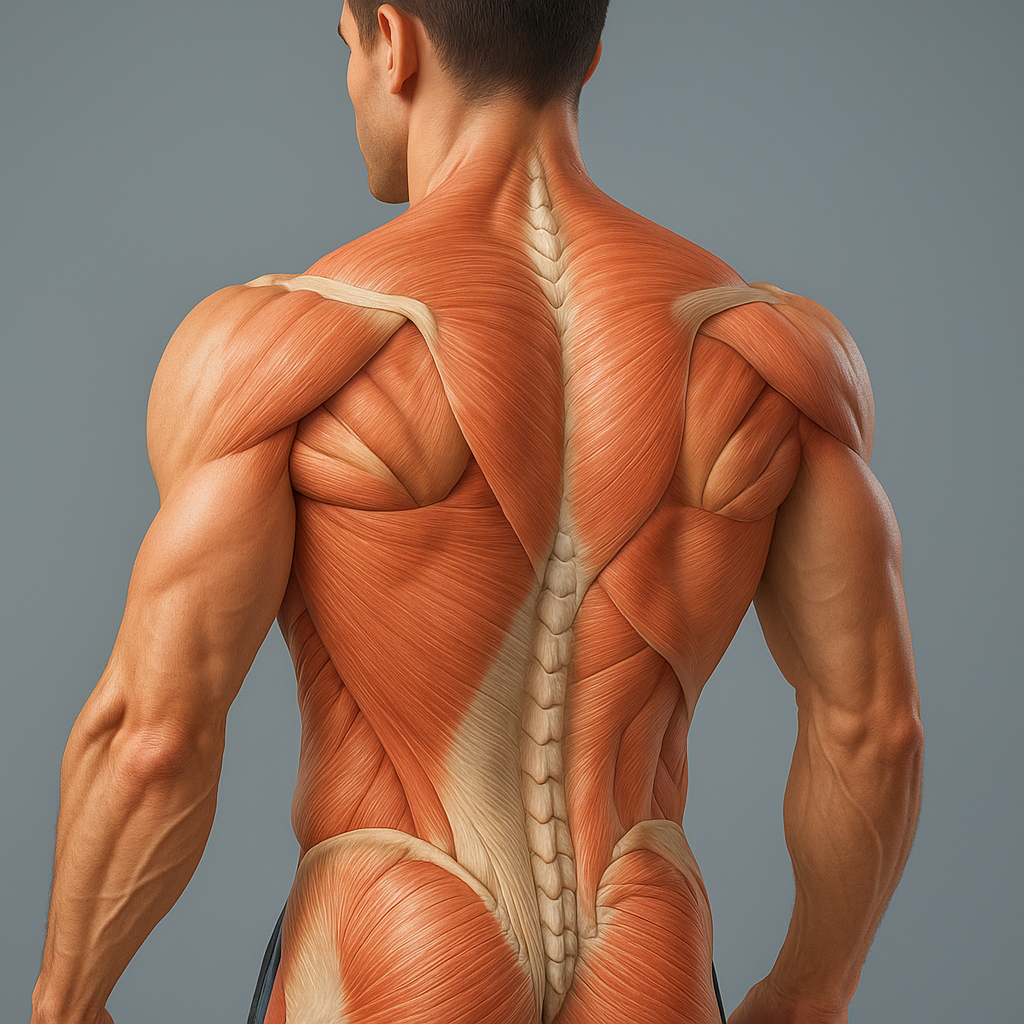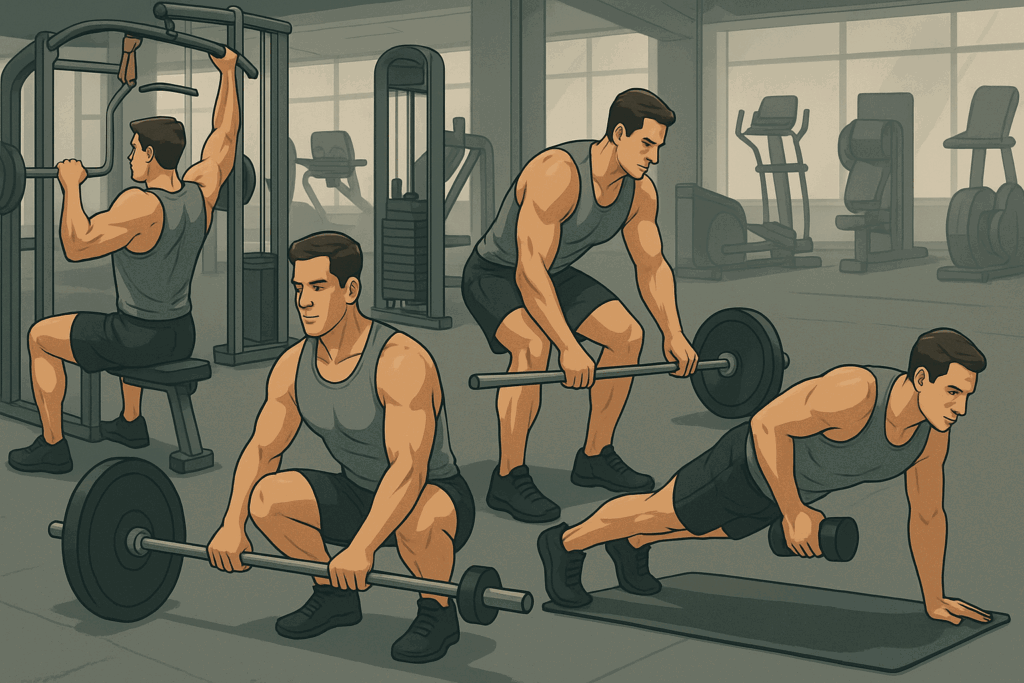Introduction: The Role of the Back Exercises Chart in Modern Strength Training
In the world of strength and conditioning, few resources are as practical and powerful as a comprehensive back exercises chart. This visual and conceptual tool serves as both a guide and a strategic framework for anyone looking to build total back strength while minimizing the risk of injury. Far more than a list of movements, a back exercises chart provides the structural clarity needed to ensure that all key muscle groups—from the spinal erectors and lats to the rhomboids and traps—are trained in balance and proportion. For athletes, fitness enthusiasts, and rehabilitation specialists alike, this kind of mapped-out system is essential in achieving long-term performance and orthopedic health.
A well-designed back training plan goes beyond aesthetics. The back is the structural engine of the human body—it stabilizes the spine, enables efficient movement, and supports nearly every physical action, whether pulling, lifting, or rotating. Weakness in any area of the posterior chain can disrupt biomechanics, hinder progress, or lead to chronic dysfunction. That’s why the development of a scientifically informed, systematically executed back workout program—ideally built on the foundation of an expertly crafted back exercises chart—is a cornerstone of any complete training strategy.
You may also like: The Ultimate 30-Day Workout Plan for Men Working Out in the Gym: Proven Full Body Strength Exercises to Maximize Results
Understanding the Anatomy: Why Back Training Demands Precision
To train the back effectively, it is crucial to understand its anatomical complexity. Unlike simpler muscle groups like the biceps or quadriceps, the back comprises a layered architecture of muscle tissue working together to perform numerous tasks. At the surface level, the trapezius and latissimus dorsi muscles dominate the visual profile. The traps are responsible for scapular elevation and retraction, while the lats play a pivotal role in pulling motions and spine stabilization. Beneath these are the rhomboids, teres major and minor, and the infraspinatus, each of which contributes to controlled shoulder mechanics and scapular support.
Deeper still lie the erector spinae and multifidus—muscles responsible for spinal extension, posture, and vertebral stability. When these muscles are neglected, individuals are more prone to back pain, disc herniations, and postural deviations. An effective back workout program must take into account the synergy among these muscle groups, ensuring that no single area is overemphasized to the detriment of another. This is where a back exercises chart becomes invaluable: it helps visualize training distribution, identify gaps in routine design, and match specific exercises to anatomical function.

Back Exercises Chart Breakdown: Key Movement Patterns for Strength and Function
A well-structured back exercises chart is built on the foundation of three core movement categories: vertical pulling, horizontal pulling, and spinal extension. Each of these represents a fundamental biomechanical action that targets different muscle groups and supports distinct functional outcomes. Vertical pulling exercises, such as pull-ups and lat pulldowns, emphasize the latissimus dorsi and teres major, making them essential components of any back workout routine for men or women. These movements develop width and contribute to the “V” taper associated with athletic physiques.
Horizontal pulling movements like barbell rows, seated cable rows, and inverted bodyweight rows prioritize the rhomboids, middle trapezius, and posterior deltoids. They also help counteract the postural imbalances caused by prolonged sitting and overemphasis on pushing exercises. Finally, spinal extension exercises such as deadlifts, good mornings, and back extensions engage the erector spinae and other stabilizing muscles of the lower back. These exercises are vital for resilience, structural integrity, and injury prevention.
By ensuring that a complete back workout includes exercises from all three categories, lifters can achieve balanced muscular development, enhance functional strength, and reduce the likelihood of overuse injuries. The back exercises chart acts as both a checklist and a roadmap for constructing this equilibrium.

Designing a Back Day Split: Structuring Volume, Intensity, and Frequency
A strategic back day split allows trainees to target the posterior chain with sufficient intensity while also managing fatigue and facilitating recovery. For most intermediate to advanced lifters, a dedicated back day within a push-pull-leg or upper-lower split is ideal. This ensures that volume can be concentrated effectively, with exercises sequenced to maximize both mechanical tension and muscular engagement. In a typical back day routine, the workout might begin with a heavy compound lift—such as deadlifts or weighted pull-ups—to stimulate high-threshold motor units and activate the central nervous system.
This is often followed by accessory work targeting specific muscle regions: barbell or dumbbell rows for mid-back hypertrophy, face pulls for scapular stability, and cable pulldowns for lat development. Programming intensity within this split depends on the goal. A back routine for mass will emphasize progressive overload, moderate-to-heavy loads, and time under tension. In contrast, a rehabilitation-focused back workout program might prioritize lighter loads, higher reps, and controlled tempos to restore function without excessive strain.
Frequency also plays a role. A once-weekly back day workout routine may suffice for beginners, but advanced lifters often benefit from a second session later in the week to focus on volume or technical skill work. Regardless of frequency, it’s essential that the back day split be customized to the individual’s training history, goals, and recovery capacity.

Essential Exercises Featured in the Back Exercises Chart
Among the most effective exercises featured in any back exercises chart are movements that deliver high stimulus across multiple joints while minimizing injury risk. The deadlift stands as a foundational pillar—an unmatched full-body exercise that especially targets the spinal erectors, traps, and lats. When performed with proper technique, the deadlift not only develops back strength but also teaches bracing and core stability, which are critical for performance and injury prevention.
Next are pull-ups and chin-ups, bodyweight staples that engage the lats, rhomboids, and biceps in concert. These movements demand strict scapular control and offer an excellent progression model through weight assistance or resistance loading. Seated cable rows, when executed with correct scapular retraction and controlled eccentric phases, isolate the mid-back effectively and are ideal for hypertrophy-based back workout programs.
Barbell rows, including Pendlay and Yates variations, deliver substantial loading to the mid and upper back, though care must be taken to maintain spinal alignment throughout the lift. T-bar rows and chest-supported row machines can be used as lower-risk alternatives with similar stimulus. Rounding out the chart are face pulls, reverse flys, and banded pull-aparts—all crucial for scapular health and rear deltoid development. Including these exercises in your complete back workout not only enhances strength and size but builds long-term durability across the entire posterior chain.

Periodizing a Back Workout Program for Maximum Adaptation
Periodization is the art and science of manipulating training variables over time to promote continual adaptation and prevent stagnation. A back workout program for mass, for example, may begin with a volume accumulation phase where trainees perform high total workloads with moderate intensity. This might involve multiple rowing and pulldown variations with 8–12 reps per set, prioritizing muscular fatigue and metabolic stress.
Following this, a strength phase can be introduced, focusing on lower rep ranges (4–6 reps) and heavier loads across compound movements such as weighted pull-ups or deadlifts. Here, total sets may be reduced while rest intervals increase, giving the nervous system time to recover between maximal efforts. Finally, a deload or recovery week helps the musculoskeletal system recuperate and adapt fully before entering the next cycle.
This cyclical structure ensures consistent gains and protects against overtraining—a common pitfall in unstructured back workout schedules. It also allows for targeted improvement: some cycles might emphasize increasing pull-up strength, while others focus on improving mind-muscle connection during rows. When programmed intelligently, periodization transforms a static back day routine into a dynamic, results-driven journey.
Customizing the Back Exercises Chart for Men’s Performance Goals
Designing a back workout routine for men often involves balancing size, strength, and aesthetics. While fundamental principles apply to all populations, men may emphasize width and thickness more aggressively due to goals rooted in hypertrophy and visual impact. The back exercises chart can be customized by highlighting movements that stimulate maximal growth in the latissimus dorsi and trapezius—such as wide-grip pull-ups, heavy barbell rows, and rack pulls.
However, it’s critical not to overlook exercises that enhance posture and reduce imbalance. Rounded shoulders and thoracic kyphosis are common in male lifters who focus too heavily on pressing without adequate posterior chain volume. Therefore, rear delt flys, face pulls, and lower trap raises should be integral parts of any balanced routine.
Additionally, men seeking to build a classic “V-taper” physique will benefit from alternating grip widths and angles to ensure comprehensive lat activation. Supinated, neutral, and pronated grips each engage the back differently and can be rotated through training blocks to maximize development. Consistently revisiting the back exercises chart as these goals evolve ensures sustained progress while minimizing redundancy and fatigue.
Back Workout Schedule Planning: Weekly and Monthly Frameworks
A well-structured back workout schedule aligns intensity and recovery to maximize results over time. In a typical weekly plan, the back is often trained either once with high volume or twice with moderate volume. For example, Monday may include heavy vertical pulls and deadlifts, while Friday focuses on horizontal rows and accessory work. This allows for both motor learning and muscular adaptation to occur with adequate recovery.
On a monthly or mesocycle level, variations in tempo, rest intervals, and exercise order can stimulate continued adaptation. One week might emphasize tempo-controlled eccentric phases to increase muscle tension, while another might introduce isometric pauses for joint stabilization and core control. Training logs, wearable tech, or simple progression spreadsheets can help track these variables across time.
Strategically syncing the back workout schedule with other muscle group sessions is also key. Deadlift-heavy days, for instance, may require reduced leg day volume to avoid systemic overload. Likewise, high-volume rowing days may impact pressing sessions if not properly spaced. This type of holistic programming reflects the true value of a structured and consistent back workout schedule: it not only builds muscle but reinforces a systemic approach to total body development.
Preventing Injury Through Intelligent Back Training
Back injuries are among the most common and debilitating issues faced by athletes and general lifters alike. While genetics and daily posture play a role, most injuries stem from technical breakdowns, muscle imbalances, and programming errors. A back exercises chart can serve as a proactive injury prevention tool by encouraging well-rounded movement selection and balanced muscular activation.
Injury-resilient training starts with proper warm-ups. Dynamic mobility drills, band activations, and progressive loading prime the spine and nervous system for heavier lifts. Once under load, maintaining neutral spine alignment and proper bracing techniques is paramount. This ensures intra-abdominal pressure supports the vertebrae, minimizing shearing forces on the discs.
Equally important is managing cumulative fatigue. Repeated spinal flexion under load—as seen in poorly executed deadlifts or rows—can lead to tissue breakdown over time. Integrating unloaded movements like bird-dogs, McGill curls, and reverse hypers reinforces spinal endurance and motor control. Restorative strategies, including mobility work, hydration, and soft tissue therapy, complement these efforts and contribute to long-term back health.

The Complete Back Workout: Integrating the Chart into Real-World Training
Bringing the back exercises chart into a practical, gym-based context involves selecting exercises that collectively address strength, hypertrophy, and resilience. A complete back workout might begin with a bilateral compound lift such as a deadlift or heavy pull-up variation, progressing to rows and pulldown exercises that vary in grip and angle. Later, isolation exercises fine-tune activation and correct imbalances, while spinal stabilizers receive attention through targeted core work.
This comprehensive structure allows the entire kinetic chain—from glutes and hamstrings to cervical stabilizers—to function as a cohesive unit. It also ensures the workload is distributed evenly, preventing muscular overuse or neglect. Whether in a bodybuilding-style split or a functional movement framework, the complete back workout should address every layer of posterior musculature.
To stay on track, trainees are encouraged to revisit and update their back exercises chart regularly. Tracking reps, load, form cues, and recovery response not only personalizes the routine but enhances engagement and accountability. Over time, this method transforms reactive training into a proactive strength and health regimen.

Frequently Asked Questions (FAQ) on Advanced Back Training Techniques and Strategy
1. What are some overlooked strategies that can improve your back day routine?
One often-overlooked strategy for enhancing your back day routine is tempo training. Adjusting the speed of each phase of a lift—especially the eccentric (lowering) portion—can significantly increase time under tension and boost muscular hypertrophy. Integrating mechanical drop sets is another advanced tactic, where you shift from a harder to an easier version of the same movement (such as switching from wide-grip to neutral-grip pull-ups) without rest. Additionally, focusing on posterior chain integration—such as pairing hamstring-loaded exercises with traditional back work—can elevate neuromuscular synergy and strengthen spinal support. Breathing techniques like intra-abdominal bracing also allow for safer, heavier lifting during complex compound movements. These methods, when incorporated into a back day routine, refine training precision and optimize results beyond conventional routines.
2. How can the back exercises chart guide lifters with different training goals?
A well-structured back exercises chart does more than list moves—it offers a tactical map tailored to varied goals like hypertrophy, endurance, or power. Lifters seeking mass might follow vertical pull and horizontal row pairings with progressive overload and lower rep ranges. Conversely, endurance-focused athletes may prioritize high-volume supersets using resistance bands and bodyweight variations from the chart. For rehabilitation or posture correction, the chart can highlight low-resistance, scapular-focused movements like face pulls or band pull-aparts. This visual framework also helps track muscle balance, ensuring both lat-dominant and mid-back areas receive proportional focus over time. Ultimately, the back exercises chart serves as a dynamic programming tool, adaptable across disciplines and training phases.
3. What mistakes should advanced lifters avoid in a back day split?
Advanced lifters often fall into the trap of volume stacking without purpose during a back day split. Redundancy—such as including multiple types of rows with similar angles—can lead to diminishing returns and fatigue without additional growth. Another mistake is neglecting unilateral work, which helps correct muscular imbalances that symmetrical training might mask. Advanced trainees also tend to over-prioritize pulling volume while underemphasizing spinal stabilizers and rear deltoid engagement. A well-designed back day split should include movement diversity across planes (vertical, horizontal, rotational), conscious recovery strategies, and occasional deloading to allow connective tissue regeneration. Avoiding these pitfalls ensures sustainable progression and injury prevention.
4. What makes a back workout routine for men uniquely effective?
A back workout routine for men can be uniquely effective when tailored to common male physiological patterns—such as naturally greater upper-body mass and a higher propensity for anterior dominance. By focusing on thoracic spine mobility, the routine can improve posture and mitigate desk-induced kyphosis, which is especially prevalent among men in sedentary jobs. Incorporating explosive power moves like high pulls and snatch-grip deadlifts caters to hormonal advantages in strength and testosterone response. Furthermore, adding isometric holds at peak contraction can refine muscular definition—an aesthetic goal many men pursue. Customizing frequency and volume around recovery capacity also helps men sustain progress in their back workout routine for men while minimizing overtraining.
5. How can periodization improve a back workout program?
Integrating periodization into a back workout program allows for strategic progression and recovery across macrocycles. Undulating periodization, which varies intensity and volume within the week, keeps the body from adapting prematurely, boosting neuromuscular gains. Linear periodization gradually increases load over weeks, which suits beginners and hypertrophy phases. Block periodization, on the other hand, separates training into distinct focus areas like hypertrophy, strength, and peaking—ideal for athletes or competitive lifters. Periodization also allows for data tracking, making it easier to adjust based on performance plateaus or injury risk. Through this scientific structuring, a back workout program becomes more than a routine—it evolves into a long-term success strategy.
6. How does a back workout schedule affect recovery and long-term gains?
A carefully designed back workout schedule balances stimulus with sufficient recovery, which is crucial for long-term muscular and structural adaptation. Training the back too frequently without modulation can lead to central fatigue, tendon strain, and plateaued performance. Implementing a split that includes heavy, moderate, and deload sessions throughout the week allows for supercompensation—the body’s natural rebound to increased strength after rest. A back workout schedule should also accommodate sleep cycles, stress levels, and nutrition to optimize recovery. Smart scheduling ensures consistent neuromuscular efficiency and mitigates risk of overuse injuries in spine and scapular stabilizers.
7. Why is the back exercises chart crucial for tracking progressive overload?
The back exercises chart provides a clear visual reference for tracking incremental improvements across different movement patterns. It enables lifters to vary angles, grips, and resistance types while maintaining progression metrics. By logging reps, tempo, and form notes within the chart, users can more easily spot weaknesses—such as lagging mid-trap development—and address them with corrective accessory work. It also fosters accountability; consistent use of the back exercises chart allows one to evaluate whether plateaus stem from physiological limits or inconsistent training variables. In essence, the chart acts as both a diagnostic and planning instrument, amplifying training sophistication.
8. How can athletes optimize a complete back workout for sport-specific performance?
Athletes can enhance a complete back workout by incorporating sport-specific movement patterns and functional strength drills. For example, rotational rows and landmine pulls benefit athletes in sports requiring trunk torque, like baseball or golf. Sprint-based athletes may prioritize resisted sled rows to increase posterior chain power and acceleration. Swimmers and climbers benefit from eccentric pull-up training to improve grip strength and lat activation under prolonged tension. A complete back workout tailored this way also includes neural priming techniques like band-resisted dynamic pulls to activate fast-twitch fibers. This integration of specificity transforms generic routines into athletic performance powerhouses.
9. What role does mental focus play in a back routine for mass?
Mental focus is a critical yet underappreciated element in building an effective back routine for mass. The mind-muscle connection—actively concentrating on engaging target muscles—enhances fiber recruitment, particularly in complex multi-joint lifts. Visualizing contraction during rows or pulldowns increases motor unit synchronization and minimizes momentum-based compensation. Techniques like slow negatives and paused reps require mental discipline but maximize hypertrophic signaling. Using auditory cues or breath pacing can also help lifters stay in rhythm and mentally “lock in” during each rep. A back routine for mass that integrates cognitive strategies often sees better symmetry and denser muscle development over time.
10. How can you customize a back workout program for mass for different body types?
Customizing a back workout program for mass involves aligning training variables with individual biomechanics and recovery capacities. Ectomorphs, who typically struggle with mass gain, benefit from lower frequency but higher intensity workouts with longer rest intervals and caloric surplus. Endomorphs may focus on higher volume circuits that enhance muscular density while managing fat accumulation. Mesomorphs can handle more frequent training and typically respond well to mixed-rep strategies within a single session. Lever lengths also matter—individuals with long arms may emphasize row variants over pull-ups for better muscle engagement. Tailoring the back workout program for mass this way ensures that genetic predispositions don’t become training limitations.
Conclusion: How a Back Exercises Chart Elevates Strength and Prevents Setbacks
Incorporating a back exercises chart into your training strategy provides a roadmap for consistent, intelligent development. It synthesizes anatomical knowledge, movement mechanics, and practical application into a structured format that guides lifters through every phase of progress—from foundational strength to advanced performance. By ensuring comprehensive activation of all back muscle groups and integrating key principles like periodization, injury prevention, and movement variety, this tool elevates the quality of training.
More than just a visual aid, the back exercises chart becomes a training philosophy—one rooted in structure, balance, and intention. For anyone pursuing a robust back routine for mass, refining a back day split, or designing a sustainable back workout program, this resource is indispensable. As fitness continues to evolve and training methods become increasingly specialized, returning to well-established fundamentals with clarity and purpose will always be the most effective approach.
Ultimately, strength is built not only through the effort we exert but through the structure that guides that effort. A well-implemented back exercises chart is that structure. It empowers the athlete, protects the body, and lays the foundation for lifelong strength, functionality, and performance.





